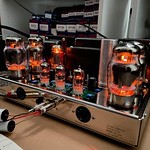 by 66tele Sat Jan 24, 2015 3:28 am
by 66tele Sat Jan 24, 2015 3:28 am
I mostly agree with MontanaWay on this one. All electrolytic caps do have a limited lifespan.....discrete caps and quad caps. So there is nothing conceptually wrong with a new quad cap, the problem is today's higher AC wall voltage. Most places in the US have wall voltage between 122 volts to as much as 130 volts (I have 126 volts at my house). Roughly 10% higher than wall voltage in the 60's, this can translate to an additional 40-60 volts DC hitting the first stage of the quad cap. This can easily exceed the voltage rating of a new replacement quad cap (ask me how I know!) and you quickly have a $40 door stop! This is the problem with current-manufacture quad caps......they don't have sufficient voltage rating. This why I've stopped using quad caps in both hifi and guitar amps.
The replacement cap boards use 8 caps, stacked in pairs in totem-pole fashion with balancing resistors. The stacked caps, usually 350 volt each, then have a combined rating of 700 volts, easily exceeding the output from the rectifier. So, no blown filter caps! This is why the cap board IS MUCH better than the quad cap and really not a preference (unless you have uncommonly low wall voltage or like replacing quad caps on a regular basis). The other problem with quad caps is that that all four sections utilize a common ground. This can create hum problems with integrated amps and guitar amps due to the inability to separately ground the filter caps with their respective stages. This can easily be done with a cap board. If manufacturers would build can caps with a higher voltage rating, then drop-in replacement would be a cinch in our old Dynaco gear.




